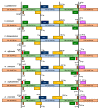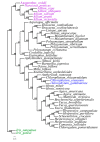Complete Chloroplast Genomes of Chlorophytum comosum and Chlorophytum gallabatense: Genome Structures, Comparative and Phylogenetic Analysis
- PMID: 32121524
- PMCID: PMC7154914
- DOI: 10.3390/plants9030296
Complete Chloroplast Genomes of Chlorophytum comosum and Chlorophytum gallabatense: Genome Structures, Comparative and Phylogenetic Analysis
Abstract
The genus Chlorophytum includes many economically important species well-known for medicinal, ornamental, and horticultural values. However, to date, few molecular genomic resources have been reported for this genus. Therefore, there is limited knowledge of phylogenetic studies, and the available chloroplast (cp) genome of Chlorophytum (C. rhizopendulum) does not provide enough information on this genus. In this study, we present genomic resources for C. comosum and C. gallabatense, which had lengths of 154,248 and 154,154 base pairs (bp), respectively. They had a pair of inverted repeats (IRa and IRb) of 26,114 and 26,254 bp each in size, separating the large single-copy (LSC) region of 84,004 and 83,686 bp from the small single-copy (SSC) region of 18,016 and 17,960 bp in C. comosum and C. gallabatense, respectively. There were 112 distinct genes in each cp genome, which were comprised of 78 protein-coding genes, 30 tRNA genes, and four rRNA genes. The comparative analysis with five other selected species displayed a generally high level of sequence resemblance in structural organization, gene content, and arrangement. Additionally, the phylogenetic analysis confirmed the previous phylogeny and produced a phylogenetic tree with similar topology. It showed that the Chlorophytum species (C. comosum, C. gallabatense and C. rhizopendulum) were clustered together in the same clade with a closer relationship than other plants to the Anthericum ramosum. This research, therefore, presents valuable records for further molecular evolutionary and phylogenetic studies which help to fill the gap in genomic resources and resolve the taxonomic complexes of the genus.
Keywords: C. comosum; C. gallabatense; chloroplast genome; phylogenetic analysis.
Conflict of interest statement
The authors affirm no conflict of interest.
Figures









References
-
- Basu S., Jha T.B. Cytogenetic studies in four species of Chlorophytum Ker-Gawl. (Liliaceae) The Nucleus. 2011;54:123–132. doi: 10.1007/s13237-011-0039-8. - DOI
-
- Govaerts R., Zonneveld B., Zona S. World Checklist of Asparagaceae. Facilitated by the Royal Botanic Gardens; Kew, UK: 2012. [(accessed on 26 February 2020)]. Available online: http://apps.kew.org/wcsp/
-
- Malpure N.V., Yadav S. Chlorophytum gothanense, a new species of Anthericaceae from the Western Ghats of India. Kew Bull. 2009;64:739–741. doi: 10.1007/s12225-009-9165-8. - DOI
-
- Govaerts R. World Checklist of Selected Plant Families Asparagaceae. Royal Botanic Gardens; Kew, UK: 2015.
-
- Lekhak M., Adsul A., Yadav S. Cytotaxonomical investigations into the genus Chlorophytum from India. Kew Bull. 2012;67:285–292. doi: 10.1007/s12225-012-9355-7. - DOI
Grants and funding
LinkOut - more resources
Full Text Sources
Miscellaneous

